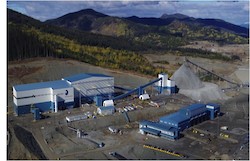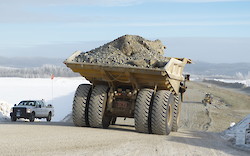Mt. Milligan Mine
Commodities: Copper (Cu) and gold (Au)
 Location: 90 km north-northwest of Prince George, BC, and 40 km west-southwest of Mackenzie.
Location: 90 km north-northwest of Prince George, BC, and 40 km west-southwest of Mackenzie.
Geology and Type of Deposit: Mt. Milligan is located in the Intermontane belt of the Canadian Cordillera. The ore is a copper-gold porphyry type deposit. Mineralization occurs mainly in volcanic rocks of the Late Triassic - Early Jurassic Witch Lake Formation, and in associated monzonite stock in a second zone. Minerals include pyrite, chalcopyrite and magnetite and bornite.
The Operation: The deposit was discovered in 1984; the feasibility study to build a mine was pursued by Terrane Metals in 2006. Thompson Creek Metals began construction in 2010 and was completed in 2013, the process involving more than 1,000 people in construction at a cost of $1.5 billion. The open-pit operation was acquired and is currently operated by Centerra Gold. It currently processes 62,500 tonnes per day; in 2022 Mt. Milligan produced 73.9 million pounds of copper and 189,000 ounces of gold. Based on current production rates, the proven and probable reserves allow mining to continue until 2033.
 Mining Method: Mining is done by conventional open pit methods. After blasting, electric shovels and front end loaders load haul trucks with ore for transport to the crushers located (X) near the mill. Waste rock that is not acid-generating is loaded into trucks and used to construct some roads and elements of the tailings storage facility (TSF). Potentially acid-generating waste rock is hauled to and placed in the TSF.
Mining Method: Mining is done by conventional open pit methods. After blasting, electric shovels and front end loaders load haul trucks with ore for transport to the crushers located (X) near the mill. Waste rock that is not acid-generating is loaded into trucks and used to construct some roads and elements of the tailings storage facility (TSF). Potentially acid-generating waste rock is hauled to and placed in the TSF.
Mineral Processing: Ore is passed through a primary gyratory crusher and on to a secondary cone crusher before being conveyed into the mill. Grinding with water begins in a SAG mill and continues in a ball mill, exiting as a sand-water slurry. The slurry is piped to flotation cells which float the copper-gold concentrate. It passes to a gravity circuit first to remove all coarse gold, and then on to a thickener cell, and finally a pressure filter that removes the water (to <9%). The concentrate is stockpiled under cover before shipping. Tailings that settle out of the flotation cells are piped to the tailings storage facility. The water is returned to the mill and reused in the milling process.
Markets: Mt. Milligan concentrate is hauled by truck from the mine to a load out facility at Mackenzie where it is loaded on to rail cars and transported to Vancouver Wharves in North Vancouver. There it is loaded onto bulk carriers and shipped across the Pacific to smelters in Japan, Korea and the Philippines.
Community and Employment: Mt. Milligan mine currently employs 460 people. The majority of live in modern camp housing on 1 week in 1 week out rotations. Most come from central BC communities of Mackenzie, Fort St. James, and Prince George, while some come from the Lower Mainland and Okanagan.
Environmental Considerations: Mt. Milligan Mine was designed from the very beginning with the closure and reclamation plan in place. It was designed to affect as small an area as possible (<5km2) and to have zero discharge of water. Pre-screening surveys included an archaeological impact assessment and wolverine, bear and fisher den surveys, to try to avoid disturbing existing areas of historical importance and wildlife habitat. Native plant surveys were also conducted to determine what should be used in reclamation.
Surface waters and groundwater in and around the mine are continuously monitored and sampled for quality, including tests for clarity, hardness, sulphate, nutrients and metals. Air quality is monitored at stations around the mine to measure dust, which poses a problem in the dry season.
New fish habitat has been constructed on Rainbow Creek to make up for loss in other areas. This includes making three large ponds (covering 3 hectares) of new trout habitat for overwintering. Seeds and seedlings of native plants have been planted in areas disturbed by construction of the ponds. Whole trees have also been planted around the edges, providing new habitat above and below the water, and snags were strategically placed to add complexity.
Learn more about the Mt.Milligan mine at Centerra Gold's website.
BCMEM's Mt.Milligan MINFILE profile.
